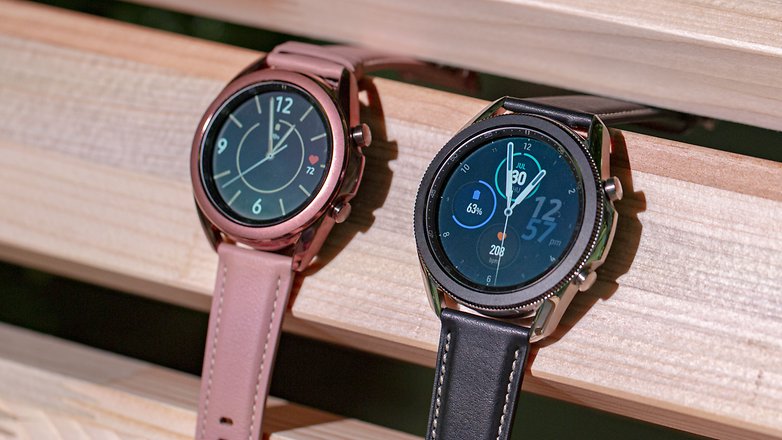Samsung Galaxy Watch 4 (Classic) vs Watch 3: What's new?


Galaxy Watch 4 or Galaxy Watch 3, or the new Classic model? We compare both of Samsung's newest generation smartwatches and show you what are the most important differences between the third and fourth generation timepieces.
Table of content:
- Watch 4 vs. Watch 3: Versions and prices
- Operating system: Wear OS replaces Tizen
- Hardware: New SoC, new sensors
- Technical specifications compared

Watch 4 (Classic) vs. Watch 3: Versions and prices
The Galaxy Watch arrives in two versions this year: the Watch 4 and the Watch 4 Classic.
The Classic model is the design successor of the Watch 3. In terms of operation, there is a mechanical bezel in addition to the touchscreen display. By turning the bezel around the display, the user will be able to scroll through lists. The Galaxy Watch 4 Classic comes with a stainless steel case that is also significantly heavier compared to the standard aluminum model.
The lighter Galaxy Watch 4 relies on aluminum for the case and in terms of design, it is more oriented towards the Active models of yesteryear. The only bezel there is here comes in a virtual format: Swiping along the touchscreen will let you scroll through lists or chats.
Model overview: Galaxy Watch 4 vs Galaxy Watch 3
| Model | Galaxy Watch 3 | Galaxy Watch 4 | Galaxy Watch 4 Classic |
|---|---|---|---|
| Sizes | 41mm / 45 mm | 40 mm / 44 mm | 42 mm / 46 mm |
| Prices (BT) | $190 / $270 | $250 / $280 | $350 / $380 |
| Prices (LTE) | - | $300 / $330 | $400 / $430 |
| Memory | 8 GB | 16 GB | 16 GB |
Those who prefer the "Classic" design with a mechanical bezel will have to accept a price increase of $100 for the Watch 4 compared to the Watch 3, or perhaps even higher than that. After all, the Watch 3 is already available for well below the MSRP if you know where to look. Furthermore, the Galaxy Watch 3 is also available in a titanium version. However, it's quite possible that Samsung will introduce a titanium version for its Watch 4 Classic at a later date.

Operating system: Wear OS replaces Tizen
Even if the new software that powers the timepieces is probably the biggest differentiating factor between the Galaxy Watch 4 (Classic) and the Watch 3, the user will hardly notice it at first. Samsung has managed to integrate its own One UI interface on Wear OS, hence regular Samsung users should quickly find their way around here. At second glance, however, there are a few exciting innovations underneath the hood.

Apps: More Google-like with wider selection thanks to Wear OS
Firstly, the Samsung Galaxy Watch 4 (Classic) has access to the Google Play Store. If you have an app installed on your smartphone that has a Wear OS equivalent, it will automatically end up on your Galaxy Watch, too. You will also be able to find the typical Google apps preinstalled on your Watch 4 (Classic), including YouTube Music or Google Maps for convenient navigation on the wrist.
With Tizen, the selection is more limited, as you have to rely on Samsung's Galaxy Store, but now that the OS has been discontinued, app developers won't necessarily place too much effort into Tizen versions down the road.
Voice assistants and payments: Watch 4 supports Google Pay
The move from Tizen to Wear OS comes with one big advantage: Google Assistant is now available as a native app. Although you could also enjoy Google Assistant on Tizen when using older Galaxy Watches, Google Assistant has had issues when running on Tizen in the past. With Wear OS on board, this should no longer be an issue.
You will also have more freedom when it comes to mobile payments. While Samsung Pay was only available on the Galaxy Watch 3, the 4 series also offers Google Pay. Users of non-Samsung smartphones should be happy about this news: All of you probably use Google Pay, right?

Tizen vs. Wear OS: Compatibility and updates
One important aspect that you should consider concerning the more affordable Watch 3: Last year's generation won't receive an update to Wear OS, and it never will. Samsung, however, has promised to continue providing its older smartwatches with security patches, and we can presume that this effort will last for three years to be in line with some of their smartphone update policies.
Yet another point to consider: unlike its predecessor, the Galaxy Watch 4 does not work with iOS. So if you use an iPhone and want to buy a Samsung smartwatch, you'll have to settle for the 3rd generation timepiece. If anyone is seriously considering doing so, please tell me why in the comments.
Hardware: New SoC, new sensors
One thing up front: the Galaxy Watch 4 and Galaxy Watch 4 Classic rely largely on a similar hardware set. Aside from the difference in design as mentioned above, battery capacity is the only other exception. But I will talk more about that later.
BioActive sensor measures body fat percentage among others
The Samsung Galaxy Watch 4 (Classic) has a new sensor that Samsung christened "BioActive." At the heart of the sensor are two electrodes that have been integrated into the buttons on the side of the watch. If you touch them, the Samsung smartwatch can measure the impedance of your upper body and thereby deduce your approximate body fat composition.
In the end, the smartwatch will show you your body fat percentage, muscle mass, water content, and other details. Since these values are only recorded for the upper body, its accuracy depends on how close your genetically determined distribution of fat reserves is to the normal range. However, it is possible to keep a record over time even though it isn't medically accurate.

Sleep monitoring with snore recorder
Pretty much like every other smartwatch out there, including the Galaxy Watch 3, the Watch 4 (Classic) keeps a record of your sleep. What's new here is continuous SpO2 measurement, which is useful for diagnosing nighttime breathing problems. In addition, the Watch 4 series has a snore detection and even records your snoring sessions if you so desire.

SoC & battery: Longer battery life thanks to 5nm SoC?
Battery life was one of the biggest criticisms that I had with the Galaxy Watch 3, especially if you use the smartwatch intensively since you will have to charge it every single day. We're used to doing so for our smartphones, but you also want to use a smartwatch at night for sleep tracking, you definitely need a "charging slot" during the day.
The Exynos W920 gave reason for brighter days ahead for the Watch 4. The SoC follows a 5 nm manufacturing process, and comes with the additional power-saving Cortex-M55 core, which takes over processing duties from the two more powerful A55 cores when in standby. As you can see in the following table, neither the battery capacity has grown significantly nor has the efficiency improved due to Wear OS and the new SoC, but rather, the opposite happened.
Battery: Galaxy Watch 4 vs Galaxy Watch 3
| Model | Watch 3 | Watch 3 | Watch 4 (Classic) | Watch 4 (Classic) |
|---|---|---|---|---|
| Size | 41 mm | 45 mm | 40 / 42 mm | 44 / 46 mm |
| Capacity | 247 mAh | 330 mAh | 247 mAh | 361 mAh |
| Runtime according to manufacturer | 43 h | 40 h | ||
As is typical with the South Korean company, there is fast charging support included, either. According to Samsung, it takes about 30 minutes to power the smartwatch's battery for up to 10 hours of use. Smartwatches from Fitbit, Garmin, Huawei and others can easily last a week with a single battery charge. Samsung, you still plenty to catch up on here.

Display: Higher resolution, more awesome?
The new Watch 4 models have received slightly improved displays. While AMOLED panels are still used, resolutions have increased slightly. In reality, this should only be noticeable on the larger model at best. There is a slight improvement in the glass above the display as Gorilla Glass DX+ is used, while the Watch 3 still carries the "normal" DX.
All technical specifications of the Watch 4, Watch 4 Classic and Watch 4 can be seen in the following table.
Technical specifications: Galaxy Watch 4 (Classic) vs Watch 3
| Model | Galaxy Watch 3 | Galaxy Watch 4 | Galaxy Watch 4 Classic |
|---|---|---|---|
| Sizes | 41mm / 45 mm | 40 mm / 44 mm | 42 mm / 46 mm |
| Dimensions | 41mm: 41.0 x 42.5 x 11.3 mm 45mm: 45.0 x 46.2 x 11.1 mm |
40mm: 40.4 x 39.3 x 9.8 mm 44mm: 44.4 x 43.3 x 9.8 mm |
42mm: 41.5 x 41.5 x 11.2 mm |
| Weight | 41mm: 48 g 45mm: 53 g |
40mm: 26 g 44mm: 30 g |
42mm: 47 g 46mm: 52 g |
| Display | 41mm: 1.2" (360×360) 45mm: 1.4" (360×360) |
40mm: 1.19" (396×396) 44mm: 1.36" (450×450) |
42mm: 1.19" (396×396) 46mm: 1.36" (450×450) |
| Processor | Exynos 9110 (10nm) | Exynos W920 (5 nm) | |
| Memory | 8 GB ROM / 1 GB RAM | 16 GB ROM / 1.5 GB RAM | |
| Operating System | Tizen OS 5.5 | One UI Watch 3.0 (Wear OS) | |
| Battery | 41mm: 247 mAh 45mm: 340 mAh |
40mm: 247 mAh 44mm: 361 mAh |
42mm: 247 mAh 46mm: 361 mAh |
It's worth mentioning here that all models are IP68 and MIL-STD-810G rated for dust and water protection. However, as always, a word of caution is advised. Samsung claims water protection up to 5 ATM and thus, theoretically offers protection up to a diving depth of 50 meters. However, higher partial pressures can occur at the surface and water can penetrate the case even if you don't go beyond the 50 meter mark underwater.
In addition, all models have GPS, WLAN, Bluetooth 5.0, NFC and either a Bluetooth or an LTE version. In terms of sensors, all models sport a pulse sensor, ECG, barometer, gyroscope, accelerometer, and ambient light sensor.

Conclusion
On paper, the Galaxy Watch 4 (Classic) offers an exciting package overall, and we liked it during our first Wrist-On (heh!). Whether the smartwatch will live up to its reputation for everyday wear will become clear in a detailed review, so you should also know by then whether the latest generation smartwatches have a clear buy recommendation over the Galaxy Watch 3. The Watch 4 will have to prove itself though, especially in terms of battery life.













